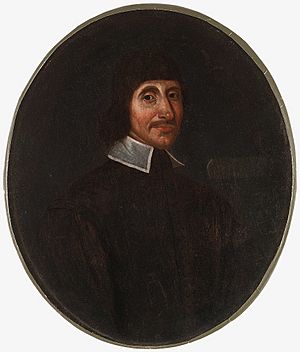John Winthrop the Younger facts for kids
Quick facts for kids
John Winthrop the Younger
|
|
|---|---|

Portrait of Winthrop, circa 1660
|
|
| Governor of the Connecticut Colony | |
| In office 1659–1676 |
|
| Preceded by | Thomas Welles |
| Succeeded by | William Leete |
| In office 1657–1658 |
|
| Preceded by | John Webster |
| Succeeded by | Thomas Welles |
| Governor of the Saybrook Colony | |
| In office 1635–1639 |
|
| Preceded by | Inaugural holder |
| Succeeded by | George Fenwick |
| Personal details | |
| Born | February 12, 1606 Groton, England |
| Died | April 6, 1676 (aged 70) Boston, Massachusetts Bay Colony |
| Spouses |
Mary Fones
(m. 1630; Elizabeth Reade
( |
| Children | 10 |
| Parents | John Winthrop Mary Forth |
| Education | Bury St. Edmunds King Edward VI School |
| Alma mater | Trinity College, Dublin |
| Signature | |

John Winthrop the Younger (born February 12, 1606 – died April 6, 1676) was an important early leader and governor of the Connecticut Colony. He played a big part in joining several smaller settlements into one strong colony.
Contents
Early Life and Education
John Winthrop the Younger was born in Groton, Suffolk, England, on February 12, 1606. His father, John Winthrop, was the first governor of the Massachusetts Bay Colony.
Young John went to grammar school in Bury St. Edmunds and then to King Edward VI School. He also studied at Trinity College, Dublin. After 1624, he briefly studied law in London at the Inner Temple.
Starting a Career in the Colonies
In 1629, Winthrop returned to England after traveling in Italy and the Levant. In 1631, he followed his father to the Massachusetts Bay Colony. He served as an assistant to the Colony's leaders in several years between 1635 and 1649.
In 1633, he was the main founder of Agawam, which is now called Ipswich, Massachusetts. He went back to England in 1634. He returned in 1635 as the governor of lands given to Lord Say and Sele and Lord Brooke. He sent a group to build a fort called Saybrook at the mouth of the Connecticut River.
Winthrop also spent time in Massachusetts studying science. He tried to get the settlers interested in using the colony's natural resources, like minerals.
Developing New Settlements
Winthrop was in England again from 1641 to 1643. When he came back, he helped set up iron works in Lynn (at the Saugus Iron Works) and Braintree, Massachusetts.
In 1645, he gained rights to land in southeastern Connecticut. He then founded New London in 1646 and moved there in 1650. He built a grist mill in the town. He was given a special right to control trade there as long as he or his family kept the mill running. This was one of the first special trade rights given in New England. One of Winthrop's Native American servants, Robin Cassacinamon, later became an important Pequot leader with Winthrop's help.
Serving as Governor
Winthrop became a judge in the Connecticut Colony in 1651. He served as governor of the colony from 1657 to 1658. He became governor again in 1659 and was re-elected every year until he died.
During his time as governor, he allowed Quakers to live in Connecticut, even though they were not allowed in Massachusetts. In 1662, he got a special document, called a charter, from England. This charter officially joined the colonies of Connecticut and New Haven. He also served as a commissioner for the United Colonies of New England in 1675.
While in England, Winthrop was chosen as a member of the new Royal Society, a group for scientists. He wrote two papers for their scientific journal, Philosophical Transactions. These papers were about "Some Natural Curiosities from New England" and "Description, Culture and Use of Maize."
Family Life
On February 8, 1630, John Winthrop the Younger married his cousin, Mary Fones. She and their baby daughter died in 1634.
His second wife was Elizabeth Reade (1615–1672). They had nine children together, including:
- Elizabeth Winthrop (1636–1716)
- Fitz-John Winthrop (1638–1707), who became a major-general in the army and later served as governor of Connecticut from 1696 until his death.
- Lucy Winthrop (1640–1676)
- Waitstill Winthrop (1642–1717)
- Mary "Mercy" Winthrop (1644–1740)
- Sara Winthrop (1644–1704)
- Margaret Winthrop (about 1648–1711)
- Martha Winthrop (1648–1712)
- Anne Winthrop (about 1649–1704)
Winthrop passed away in Boston on April 6, 1676. He had gone there to attend a meeting of the commissioners of the United Colonies of New England.
Notable Descendants
Some of Winthrop's descendants played roles in American history. Paul Dudley Sargent was a colonel during the American War of Independence. Dudley Saltonstall was a naval commander during the same war.
See also
 In Spanish: John Winthrop el Joven para niños
In Spanish: John Winthrop el Joven para niños


